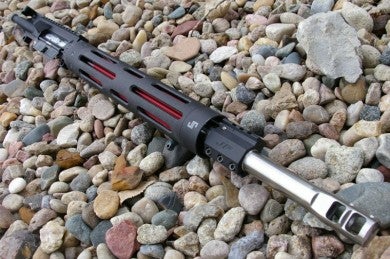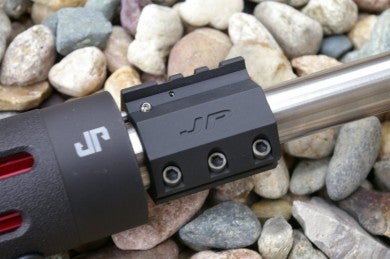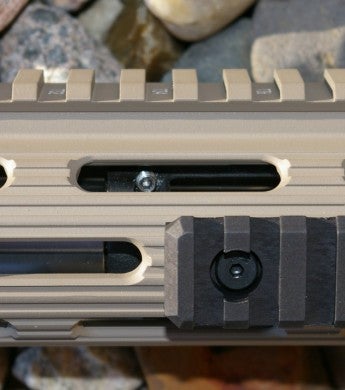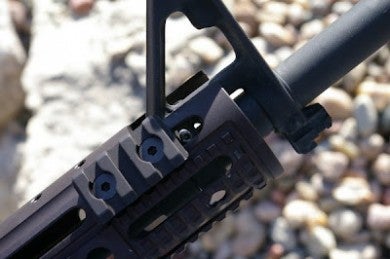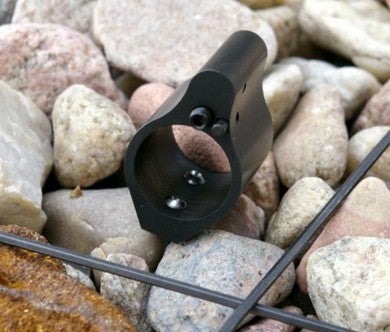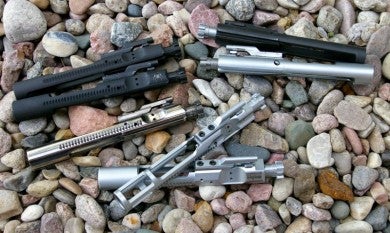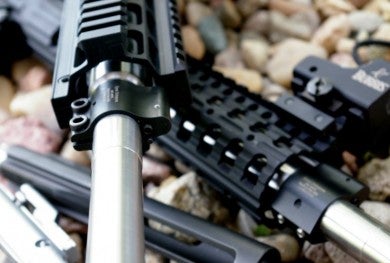All About Adjustable AR Gas Blocks
Major Pandemic 12.17.13
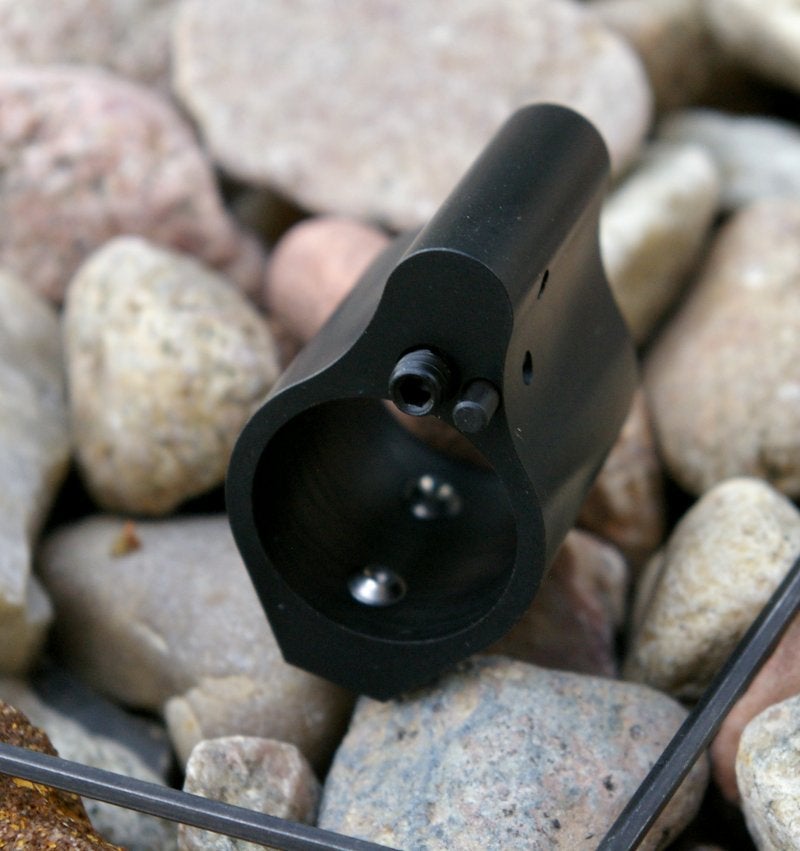
This last weekend, I provided a buddy a side-by-side comparison of his standard AR and one of my AR-15s with an adjustable gas block. His actual quote was, “Holy crap. When can you do that to mine?” Your first experience with an adjustable gas block will be an enlightening one. The near absence of recoil and almost non-moving sight picture is stunning to say the least, in the “Holy crap, why did I not do this before?” kind of way. I maintain that an adjustable gas block is the most significant performance upgrade anyone can make to their AR format rifle.
After my very first JP adjustable gas block, I was sold on the having the ability to tune the gas pressure on a standard direct impingement AR-15 system. The advantages are a plenty: a large reduction in recoil, faster recoil recovery, faster sight picture acquisition between shots, heat reduction at the bolt, and a bit cleaner running.
The Case for Adjustable Gas Blocks
All things in the gas system must be in a zen state of balance, and generally on an AR-15 direct impingement system, they are pretty unbalanced, tipping gluttonously in favor of a guarantee of reliability while making the deep sacrifice of heavier recoil in the process.
A direct impingement system works pretty simply; the round fires, the bullet travels down the barrel, pressure is leached off via a gas port (small hole) in the barrel which pushes gas up into a gas block, and the gas block reroutes the gas back down the gas tube and back into the BCG (bolt carrier group). That pressure presses on the bolt o-rings inside the carrier, which unlocks the bolt and cycles the action. Repeat until the magazine is empty.
The length and internal dimensions of gas tube, size of gas port in the barrel, internal dimensions of the gas block, placement of the gas block on the barrel gas port (correctly or incorrectly), barrel length, type of compensator or suppressor, placement of the gas port on the barrel more forward or backward, friction of the BCG, position and condition of the o-rings on the bolt, weight of the buffer, rate of the buffer spring, weight of the rifle, rate of powder burn of the ammo, amount of powder, how hot the primer is, bullet weight, whether the BCG bounced during the last cycle and is oh-so-slightly out of battery or not, a shooter’s shooting style, and more all play roles which much be kept in a zen-like balance for the rifle’s functioning to be optimally tuned. Generally though, manufacturers have errored on the obscenely over-gassed side to guarantee reliability, even if it does beat up the shooter.
For many of us, the palm to the forehead/illuminating moment comes when we try a mid-length or rifle-length gas system with less recoil that seems to run longer, cleaner, and cooler to some degree, all while being more reliable. Hmmm, less gas pressure.
All an adjustable gas block does is adjust gas pressure just like a faucet does with water. Even by turning that gas pressure down significantly, most gas system are so over-gased that total reliability can still be had while delivering huge benefits to the shooter. Today we can control gas pressure with Adjustable Gas Blocks like those from Syrac Ordnance. By using even lighter weight Bolt Carrier Groups from Young or JP and low mass buffers and springs, we can turn that gas down even more for an amazingly light recoiling AR-15.
How an Adjustable Gas Block Works
Most people view the adjustable gas block in the same mindset as a fad like Shake Weights or Chia Pets, instead of the innovation that it is. Oddly many of these doubters I have talked with seem to embrace the adjustable piston systems which [cough] are in essence adjustable gas systems [cough], but they think adjustable direct impingement systems somehow have less merit. I am a believer in adjustable gas systems, and I have shocked and awed myself and others during testing with the dramatic metamorphosis which occurs from transforming a punchy 5.56 AR-15 to a flat, soft, and fast shooting firearm by just by reducing gas pressure.
Generally all “adjustable” gas blocks work the same. A screw simply pinches closed the gap between the barrel gas port and the gas tube, just like a faucet controlling a stream of water.
There are now a ton of adjustable gas blocks on the market which offer a screw stuck in a gas block. The idea is so simple that even a lightly skilled individual such as myself has converted three standard gas blocks to adjustable versions on two carbines and one mid-length rifle system. The most significant problem becomes locking in the adjustment. This is where the patented Syrac Ordnance adjustable gas block is the best option. It locks into position with a detent, so the adjustment will never move on you.
How to Tune an Adjustable Gas Block for Performance and Reliability
- Assure the firearm is unloaded and the chamber is clear. Syrac recommends tuning on a dry un-oiled rifle with the lightest load you will use.
- Carefully, turn the adjustment screw all the way down clockwise until it bottoms out (approximately three full turns) and then back off one full turn.
- Load one round in the magazine and seat the magazine.
- Shoot the gun with an offhand shooting position. The bolt should lock back. If the BCG locks back, move on to step 5. If not, skip to step 6.
- If the BCG locks back, turn the screw clockwise in ¼ turn increments repeating the steps 4-5 until the bolt no longer holds back, then back out counter-clockwise ¼ turn and proceed to step 6.
- If the BCG does not lock back, turn the screw counter-clockwise in ¼ turn increments, repeating the steps 4-6 until the bolt holds back, and proceed to step 7.
- Increase in counter-clockwise ¼ turn increments as needed until the bolt holds back successfully three consecutive single round shots.
- If successful, your AR-15 is now optimally tuned for that ammo.
- If concerned with assuring reliability with a broader range of ammo, then add ¼ or 1/2 counter-clockwise turn. You will get a bit more recoil, however your reliability will increase if you swap ammo a lot. I usually add 1/2 turn and rarely have any problems going forward with any ammo.
NOTE – If you move an upper to a different lower, make sure that you use the buffer and buffer spring from the lower that you used to tune the upper, otherwise the gas block should be re-tuned.
Tuning Observations
Once you get things set up and tuned plus that 1/4 or 1/2 extra counter-clockwise turn, you will rarely if ever have any reliability issues while enjoying a better shooting AR.
With an adjustable gas block, a standard AR-15 BCG, a buffer and buffer spring is actually preferred instead of heavier H1 and H2 variants, will allow a lower gas pressure setting, and will net you the biggest benefit of recoil reduction. After all, a lighter BCG, buffer, and buffer spring requires less gas pressure to move.
It has been my experience that heavy buffers, heavy buffer springs, and M16 carrier groups increase tuning complexity as this extra mass is more sensitive to gas pressure and ammunition changes. ARs with these heavier components will require a higher gas pressure setting for operation and will deliver slightly more recoil when compared to systems with standard components.
Contrary to rumors on some forums, so far none of my adjustable gas blocks have required special cleaning of any kind.
As noted above, if you move an upper to a different lower then you must ensure that you use the buffer and buffer spring from the lower that you used to tune the upper, otherwise the gas block should be re-tuned. Additionally, changes to muzzle brakes or flash hiders, changes to buffer, buffer spring, carrier, bolt, and handloads or low velocity rounds may require re-tuning for optimal reliability.
Final Thoughts
I would recommend JP, PRI, or Syrac Ordnance Gas blocks, but there are others that I simply have not tried. The other option is to make one with a little patience. All it really takes is a drill bit, a tap, and a screw. The JP models offer a top picatinny rail, and Syrac Ordnance provide a low profile alternative and locking detent settings in a package that will slip under even the skinniest handguards.
Adjustable gas blocks deliver a dramatic advantage for AR owners, and in my opinion are the most significant performance upgrades you can make to shoot faster, reduce fatigue on you and your firearm, and may potentially make your AR-15 shoot longer without the need for cleaning. Adjust away.
